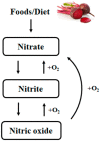Current Knowledge on Beetroot Bioactive Compounds: Role of Nitrate and Betalains in Health and Disease
- PMID: 34200431
- PMCID: PMC8229785
- DOI: 10.3390/foods10061314
Current Knowledge on Beetroot Bioactive Compounds: Role of Nitrate and Betalains in Health and Disease
Abstract
An increase in the prevalence of noncommunicable chronic diseases has been occurring in recent decades. Among the deaths resulting from these conditions, cardiovascular diseases (CVD) stand out as the main contributors. In this regard, dietary patterns featuring a high content of vegetables and fruits, such as the Mediterranean and the DASH diets, are considered beneficial, and thus have been extensively studied. This has resulted in growing interest in vegetable-derived ingredients and food-supplements that may have potential therapeutic properties. Among these supplements, beetroot juice, which is obtained from the root vegetable Beta vulgaris, has gained much attention. Although a significant part of the interest in beetroot juice is due to its nitrate (NO3-) content, which has demonstrated bioactivity in the cardiovascular system, other ingredients with potential beneficial properties such as polyphenols, pigments and organic acids are also present. In this context, the aim of this review article is to analyze the current knowledge regarding the benefits related to the consumption of beetroot and derived food-supplements. Therefore, this article focuses on nitrate and betalains, which are considered to be the major bioactive compounds present in beetroot, and thus in the derived dietary supplements.
Keywords: beetroot; betalains; dietary supplement; nitrate.
Conflict of interest statement
The authors declare no conflict of interest.
Figures





Similar articles
-
Red Beetroot Betalains: Perspectives on Extraction, Processing, and Potential Health Benefits.J Agric Food Chem. 2020 Oct 21;68(42):11595-11611. doi: 10.1021/acs.jafc.0c04241. Epub 2020 Oct 11. J Agric Food Chem. 2020. PMID: 33040529 Review.
-
Biological effects of red beetroot and betalains: A review.Phytother Res. 2020 Aug;34(8):1847-1867. doi: 10.1002/ptr.6653. Epub 2020 Mar 14. Phytother Res. 2020. PMID: 32171042 Review.
-
A Nitrate-Rich Vegetable Intervention Elevates Plasma Nitrate and Nitrite Concentrations and Reduces Blood Pressure in Healthy Young Adults.J Acad Nutr Diet. 2020 Aug;120(8):1305-1317. doi: 10.1016/j.jand.2020.02.014. Epub 2020 May 5. J Acad Nutr Diet. 2020. PMID: 32386891 Clinical Trial.
-
Valorization of Red Beetroot (Beta vulgaris L.) Pomace Combined with Golden Linseed (Lini semen) for the Development of Vegetable Crispbreads as Gluten-Free Snacks Rich in Bioactive Compounds.Molecules. 2024 May 2;29(9):2105. doi: 10.3390/molecules29092105. Molecules. 2024. PMID: 38731596 Free PMC article.
-
Bioactive potential of beetroot (Beta vulgaris).Food Res Int. 2022 Aug;158:111556. doi: 10.1016/j.foodres.2022.111556. Epub 2022 Jun 23. Food Res Int. 2022. PMID: 35840248 Review.
Cited by
-
Impact of a short-term nitrate and citrulline co-supplementation on sport performance in elite rowers: a randomized, double-blind, placebo-controlled crossover trial.Eur J Appl Physiol. 2024 Jun;124(6):1911-1923. doi: 10.1007/s00421-024-05415-4. Epub 2024 Feb 10. Eur J Appl Physiol. 2024. PMID: 38340156 Free PMC article. Clinical Trial.
-
Betalains: A Narrative Review on Pharmacological Mechanisms Supporting the Nutraceutical Potential Towards Health Benefits.Foods. 2024 Dec 3;13(23):3909. doi: 10.3390/foods13233909. Foods. 2024. PMID: 39682981 Free PMC article. Review.
-
Acute Effects of Dietary Nitrate on Central Pressure and Endothelial Function in Hypertensive Patients: A Randomized, Placebo-Controlled Crossover Study.Arq Bras Cardiol. 2023 Jan 9;120(1):e20220209. doi: 10.36660/abc.20220209. eCollection 2023. Arq Bras Cardiol. 2023. PMID: 36629601 Free PMC article. Clinical Trial. English, Portuguese.
-
In Vitro, Ex Vivo, and In Vivo Evidence of Nitrate-Reducing Activity in Levilactobacillus brevis CD2: A Potential Tool for Oral and Systemic Health Applications.Foods. 2025 Apr 26;14(9):1512. doi: 10.3390/foods14091512. Foods. 2025. PMID: 40361594 Free PMC article.
-
Plasma-Activated Water (PAW) Decontamination of Foodborne Bacteria in Shucked Oyster Meats Using a Compact Flow-Through Generator.Foods. 2025 Apr 25;14(9):1502. doi: 10.3390/foods14091502. Foods. 2025. PMID: 40361586 Free PMC article.
References
-
- Papadaki A., Martínez-González M.A., Alonso-Gómez A., Rekondo J., Salas-Salvadó J., Corella D., Ros E., Fitó M., Estruch R., Lapetra J., et al. Mediterranean diet and risk of heart failure: Results from the PREDIMED randomized controlled trial. Eur. J. Heart Fail. 2017;19:1179–1185. doi: 10.1002/ejhf.750. - DOI - PubMed
Publication types
Grants and funding
LinkOut - more resources
Full Text Sources
Medical

